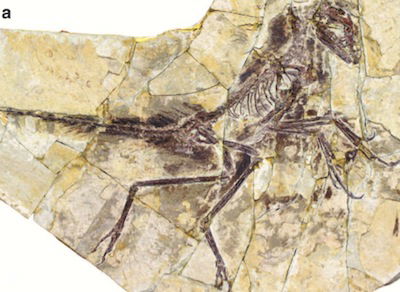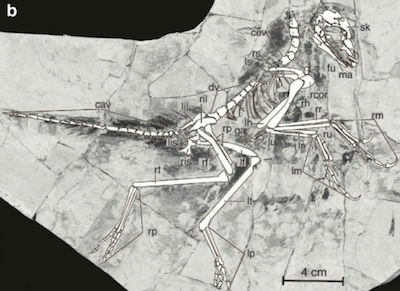
How Can We Say a Feathery Dinosaur is a Bird?
How can we say it's a bird?
News Source
- National Geographic: “Tiny Feathery Dinosaur Raises Jurassic Questions”
Since last week’s discussion of the feathered fossil Eosinopteryx, we have received questions about how we could consider this animal a bird. For instance, a Facebook inquirer responding to Ken Ham’s blog on the same subject questioned our contention that this animal was a bird. Frustrated with the difficulty of obtaining the published research data, he graciously wrote:
I've been a fan of this page for a long time now, maybe a year, maybe two; and generally I agree with you.
But this hand-waving about this being a bird is something I have to speak up on. If you look at the actual fossils, no one could honestly say that this is “just a bird.” It doesn't have the skeletal structure that would allow for extended flapping flight. It's wings are far too short. The forelimbs have claws digits and most of all IT HAS TEETH. What bird has teeth? As someone who has studied avian biology, this blog post is very misleading and very poorly put together. I do hope you reconsider this and look at the data again.
[Another reader suggested: “There is a link in the blog to a much more detailed article, ‘Was Tiny Feathered Creature Dinosaur or Bird?’, that addresses some of that.”]
[He continues,] I read the entire article, it doesn't come close to addressing any of it. I actually had to look elsewhere to even get the actual data from the original research because it wasn't included.
A blog post by ardent evolutionist PZ Myers was somewhat less gracious. Despite evolutionist Michael Zimmerman’s recent plea to avoid “name-calling” in commenting about creationists (which is discussed further in item 5 of today’s column), Myers says that we are “idiots.”1


Is it a bird? Is it a dinosaur? Whatever it is, it clearly has feathers. Like more familiar birds, Eosinopteryx brevipenna has relatively short femurs that appear tucked up into the body (labelled lf and rf in the line drawing) and elongated metatarsal bones (upper parts of the feet, which are labelled rp and lp, for right and left “pes”). Eosinopteryx also resembles previously discovered extinct birds. Despite having feathered wings, like some modern flightless birds, Eosinopteryx's wings do not appear to have been adapted for flight. They are a bit on the short side. Also, the forelimb bones (radius and ulna: rr, ru, lr, and lu) seem aligned in a way that would make successful flight-generating flapping unlikely. Be sure to have a look at the close-up photo of one of Eosinopteryx's feathers in “Was Tiny Feathered Creature Dinosaur or Bird?.” Image credit: P. Godefroit et al., “Reduced plumage and flight ability of a new Jurassic paravian theropod from China,” Nature Communications (2013) doi:10.1038/ncomms2389 published online 22 January 2013.
A professor of biology, Myers cited the animal’s teeth, wing claws, bony tail, and lack of a bony keel in its chest as proof the animal could not have been a bird. Yet it shares all these characteristics with Archaeopteryx, which until recently was considered even by evolutionists to be a bird.
“While there are no living birds with teeth, other fossilized birds such as Hesperornis also had teeth.”
As Dr. David Menton explains in the creationist text New Answers Book 1, “While there are no living birds with teeth, other fossilized birds such as Hesperornis also had teeth. Some modern birds, such as the ostrich, have fingers on their wings, and the juvenile hoatzin (a South American bird) has well-developed fingers and toes with which it can climb trees.”
Myers went on to say that Eosinopteryx lacked the “skeletal and muscular structure to allow for extended flapping flight, and the wings are way too short for it to have been an adequate flyer.”2 Yet neither our News to Note item nor Ken Ham’s blog ever suggested Eosinopteryx could fly. In fact, we noted that Eosinopteryx's wingspan was a bit short and that its forelimb bones were relatively short and appeared oriented in a way that would preclude efficient flight-generating flapping. But since when did an animal have to fly to be a bird? We have flightless birds alive today, and they are well-adapted for their earth-bound lifestyles. Yet no one disputes their identity as birds. Some modern flightless birds even have “stubby wings,” unusual feather distribution, and lack bony keels in their chests. Ostriches and kiwis, for instance, have no keel. Cassowaries don’t have pennaceous tail feathers. Kiwi wings are quite puny, and the Galapagos cormorant’s wings are about a third the length it would need to fly.
Examining the photographs and description of Eosinopteryx, we noted that in addition to pennaceous feathers it had some skeletal features consistent with those seen in birds in general—relatively short femurs (upper leg bones) appearing tucked up within the body and elongated metatarsals (upper part of the feet, also known as “tarsometatarsals”), for instance—as well as features seen in extinct birds like Archaeopteryx and especially Anchiornis. The authors themselves noted these features. In fact, Eosinopteryx is so similar to Anchiornis that there was a question whether it was really a new species or just an Anchiornis that was molting when it died. And Anchiornis fossils clearly do contain well-preserved mature pennaceous feathers.
We are not saying that all extinct birds are identical to modern birds. That would be foolish. Some extinct birds (like Archaeopteryx and Anchiornis) differ in that, for instance, they have teeth, wing claws, and have less bone fusion than typical modern adult birds. The lower degree of bone fusion could be a feature of an immature bird, but it may well have simply been characteristic of those birds as adults. (Degree of bone fusion is a feature paleontologists must often rely upon in trying to distinguish young from mature animals in general.)
Archaeopteryx also lacked a bony keel. Whether it had a cartilaginous keel that was not preserved or no keel at all we cannot be certain. Flight muscles could have been attached to its somewhat L-shaped wishbone or to a cartilaginous keel. Either way, mounting evidence suggests that it could fly.
Computer databases classifying birds as dinosaurs—a classification made on the basis of evolutionary presuppositions that birds evolved from dinosaurs and therefore should be considered dinosaurs—were used to re-classify Archaeopteryx as a dinosaur. (Read more about this controversial study that appeared in Nature in 2011 at “Dinosaur-Bird Confusion” and “An Ode to Archaeopteryx”).
Even evolutionary science writer Brian Switek, when discussing Eosinopteryx, commented on the vagaries of whether to call a creature a bird or a dinosaur. Switek wrote:
Does this mean that we should stop calling
Archaeopteryx the earliest known bird? Not necessarily.
'[T]his phylogeny remains only weakly supported,' Godefroit and coauthors caution. . . .
Birds are a special lineage of coelurosaurian dinosaurs. That is a fact. But the details of when and how that transition occurred, not to mention exactly from whom, are still areas of active debate.
As to our Facebook reader's frustration with the difficulty obtaining the original research data, we do sympathize, but that is beyond our control. The data was contained in published copyrighted material that is not freely available to the public. We must purchase the rights to even read the material and certainly cannot republish it on our website beyond the limits of what is permitted under “fair use” copyright laws.
When it comes down to whether to call an animal a bird or a dinosaur, as we noted last week the reclassification of birds as dinosaurs is based on the evolutionary presupposition that they evolved from dinosaurs. And when computerized analysis of anatomical data is conducted in comparison with databases that already consider birds to be dinosaurs, naturally the computer’s answer to “what is it?” is “dinosaur.” Apart from those evolutionary presuppositions, though, extinct birds that happen to have feathers, teeth, wing-claws, and no bony keel remain just another kind of bird. And a bird that probably ran around on the ground because it wasn’t equipped for flight would be considered—apart from evolutionary presuppositions—just an extinct kind of flightless bird.
Further Reading
- Did Dinosaurs Turn into Birds?
- The Evolution of Feathers: A Major Problem for Darwinism
- On the Alleged Dinosaurian Ancestry of Birds
- Dinosaurs for Thanksgiving (Turkey Day)
- Feathered Dinosaurs Found in Canada? (Bird-mimicking dinosaurs)
- Fine Filaments for Feathered Dinosaurs (“proto-feathered” dinosaurs)
- Dinosaur-Bird Confusion (oldest bird knocked off its perch)
- Final “Proof” for Fuzzy Dinos (Anchiornis)
- Canadian Amber Holds Fuzzy Fossils (dino-fuzz)
- Gigantic Dinosaur Reportedly Has Fossilized Feathers (“beautiful feathered tyrant”)
- Scientific American Admits Creationists Hit a Sore Spot
- New Dinosaur-Bird Link?
- Yet Another New “Feathered” Dinosaur? (Sinornithosaurus)
- New Evidence Finds Dinosaurs Ate Birds (dinosaur cuisine?—Microraptor)
- (Microraptor)
- Formed to Fly
For More Information: Get Answers
Remember, if you see a news story that might merit some attention, let us know about it! (Note: if the story originates from the Associated Press, FOX News, MSNBC, the New York Times, or another major national media outlet, we will most likely have already heard about it.) And thanks to all of our readers who have submitted great news tips to us. If you didn’t catch all the latest News to Know, why not take a look to see what you’ve missed?
(Please note that links will take you directly to the source. Answers in Genesis is not responsible for content on the websites to which we refer. For more information, please see our Privacy Policy.)
Footnotes
- PZ Myers, “Only a bird,” freethoughtblogs, Pharyngula, February 4, 2013.
- Ibid.”
Recommended Resources

Answers in Genesis is an apologetics ministry, dedicated to helping Christians defend their faith and proclaim the good news of Jesus Christ.
- Customer Service 800.778.3390
- Available Monday–Friday | 9 AM–5 PM ET
- © 2025 Answers in Genesis




